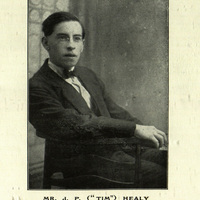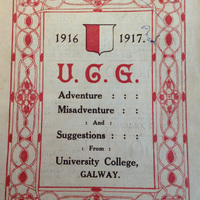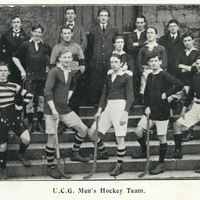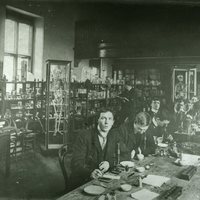Student Life on the Outbreak of War / Saol an Mhic Léinn Nuair a Bhris an Cogadh Amach
At the outbreak of the war in 1914, the University admitted 52 new entrants, bringing the total student body to 206.
The most popular subjects were modern languages, followed by natural philosophy (physics) and Irish. In 1914, there were 196 students from within Connacht itself with academically gifted students from humble backgrounds benefiting from new County Council scholarships that allowed a generation of exceptional students to gain access to third level education.
The social and political character of the student body changed perceptibly during the early decades of the twentieth century with the establishment of the National University in 1908. Commenting on the effects of the 1908 Act that transformed the Queen’s Colleges into the National University, the students’ 1914 College Annual claimed that before 1908, the College students ‘were in Galway but not of Galway, they were from Ireland but not of it’. Proudly proclaiming the new political character of the students at the University, the magazine continued,
‘We are no longer as of old, we have lost much of the tradition of Queen’s. There are many students today who show no fellow feeling with the students of the past’.
Students lived off campus in ‘digs’, as lodgers in residential homes, because there was no on-site student accommodation. Male students were a familiar sight in the upmarket bars and hotels in Galway town and comprised a distinct social set among the town’s elite. Students of the College gained automatic membership of the socially exclusive Galway Golf Club and the Corrib Boating Club. Sporting societies provided welcome distractions from studies with College teams competing in men’s rugby, handball, tennis, boating, cricket, boxing, hockey and Gaelic football and hurling; and ladies’ teams competing in tennis, hockey and camogie. With relatively small numbers, the students struggled to compete against other universities and most competitions were held with local teams from Galway town. The camogie team achieved a rare distinction in 1916, however, when it won the Ashbourne Cup, the annual intervarsity tournament. In 1915 the University transferred funding from the College Rugby Society to the Hurling Club, an indication of the changing political character of the College, as rugby was increasingly identified with Unionist sentiment by a new generation of middle class nationalist students.
A Students’ Representative Council was formed in 1914, the object of which was, ‘the provision of means for the social intercourse of its members’ and facilities included a reading room, games room, billiard room and gymnasium’. Social, cultural and romantic opportunities were provided by the Dramatic Society which produced two annual plays, the Gaelic Society which met fortnightly and the Orchestral and Choral Societies which practised weekly. Upon the outbreak of the war, however, the Debating Society, ‘refrained from putting before the house any debates of too controversial a nature; a debate which, however desirable in normal times, would nowadays bring disruption and discord within our ranks’. In late 1914, a motion before the Society stating that, ‘A knowledge of Irish was not an essential qualification for an Irishman’ was lost, demonstrating the increasing assertiveness of cultural nationalism in the university.
Saol an Mhic Léinn Nuair a Bhris an Cogadh Amach
Nuair a bhris an cogadh amach i 1914, ghlac an Ollscoil le beirt iontrálaithe nua is leathchéad; bhí 206 mac léinn san iomlán cláraithe ansin.
Ba iad na nuatheangacha na hábhair ba mhó éilimh, agus ina dhiaidh sin an fhealsúnacht nádúrtha (fisic) agus an Ghaeilge. Sa bhliain 1914, tháinig céad is nócha sé mac léinn as Connachta féin agus bhain go leor mac léinn as teaghlaigh bhochta a raibh féith na hacadúlachta ag baint leo tairbhe as scoláireachtaí nua na Comhairle Contae a thug deis do ghlúin mac léinn den scoth teacht a bheith acu ar an oideachas tríú leibhéal.
Bhí athrú ar dhéanamh sóisialta agus polaitiúil na mac léinn le tabhairt faoi deara i dtús na haoise nuair a bunaíodh Ollscoil na hÉireann sa bhliain 1908. Ag labhairt dóibh ar thionchar Acht 1908 a rinne Ollscoil Náisiúnta de Choláistí na Banríona, d’áitigh iris bhliantúil na mac léinn in 1914 go raibh mic léinn an Choláiste ‘in Galway but not of Galway, they were from Ireland but not of it’ roimh 1908. Ag fógairt go hard go raibh claonadh nua polaitiúil ag mic léinn na hOllscoile, dúirt an iris,
We are no longer as of old, we have lost much of the tradition of Queen’s. There are many students today who show no fellow feeling with the students of the past.
Chuir mic léinn fúthu i lóistín lasmuigh den champas, áit a dtógfadh siad seomraí ar cíos i dtithe cónaithe, agus ní raibh aon lóistín do mhic léinn ar an gcampas. Ba mhinic le mic léinn fhireanna a bheith sna beáir agus sna hóstáin ghalánta i mbaile na Gaillimhe agus ba ghrúpa sóisialta ar leith iad i measc scothaicme an bhaile. Fuair mic léinn an Choláiste ballraíocht láithreach i gClub Gailf na Gaillimhe agus i gClub Bádóireachta na Coiribe, rud a léirigh a stádas sóisialta ar an mbaile.
B’iontach an bealach le scíth a thabhairt don intinn ón staidéar iad na cumainn spóirt. Bhí fir an Choláiste san iomaíocht i rugbaí, liathróid láimhe, leadóg, bádóireacht, cruicéad, dornálaíocht, haca mar aon le hiománaíocht agus peil Ghaelach agus bhí na mná san iomaíocht sa leadóg, sa haca agus sa chamógaíocht. De bharr go raibh líon na mac léinn sách beag, bhí sé deacair orthu a bheith san iomaíocht i gcoinne ollscoileanna eile agus ba in aghaidh foirne áitiúla as baile na Gaillimhe is mó a bhí siad in iomaíocht. D’éirigh thar barr leis an bhfoireann camógaíochta sa bhliain 1916, áfach, nuair a bhuaigh siad Corn Ashbourne, an comórtas bliantúil idirollscoile. Sa bhliain 1915, d’aistrigh an Ollscoil maoiniú ó Chumann Rugbaí an Choláiste go dtí an Club Iománaíochta, léiriú ar an athrú a bhí ag teacht ar chúrsaí polaitíochta an Choláiste, mar shamhlaigh glúin nua de mhic léinn mheánaicme náisiúnacha gur bhain rugbaí aitheanta leis an aontachas.
Bunaíodh Comhairle Ionadaíoch na Mac Léinn sa bhliain 1914, agus é mar aidhm aici acmhainní a chur ar fáil do chúrsaí sóisialta na mball, agus i measc na n-áiseanna a bhí ar fáil bhí seomra léitheoireachta, seomra cluichí, seomra billéardaí agus giomnáisiam. Cuireadh deiseanna sóisialta, cultúrtha agus rómánsúla ar fáil tríd an gCumann Drámaíochta, a chuir dhá dhráma ar stáitse gach bliain, an Cumann Gaelach, a chas le chéile gach coicís agus an Cumann Ceolfhoirneach agus an Cumann Córúil a tháinig le chéile chun cleachtadh a dhéanamh gach seachtain. Nuair a thosaigh an cogadh, áfach, shocraigh an Cumann Díospóireachta gan aon díospóireacht a chur os comhair an tí a bheadh róchonspóideach agus a chruthódh aighneas sa Chumann, is cuma cé chomh hinmhianaithe is a bheadh díospóireacht dá leithéid de ghnáth. Ag deireadh 1914, níor éirigh le rún a cuireadh os comhair an Chumainn a d’áitigh nár theastaigh eolas ar na nGaeilge ó dhuine le bheith ina Éireannach, rud a léirigh an treallús a bhí ag teacht faoin náisiúnachas cultúrtha san ollscoil.






